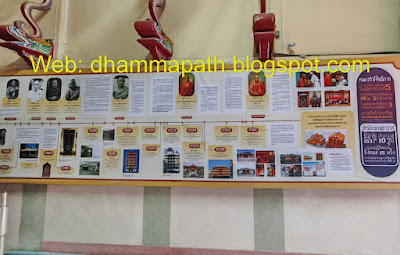Temple Wat Mangkon Kamalawat, also known as Wat Leng Noei Yi, is conveniently located in Bangkok’s Chinatown district, making it the largest and most significant Chinese Buddhist temple in Bangkok. Within its sacred halls, worshippers and visitors alike are greeted by the serene presence of deities statue. Wat Mangkon Kamalawat was founded as a Mahayana Buddhist temple in 1871 or 1872, by Phra Archan Chin Wang Samathiwat (also known as Sok Heng), initially with the name Wat Leng Noei Yi. It was later given its current name, Wat Mangkon Kamalawat, meaning "Dragon Lotus Temple", by King Chulalongkorn (Rama V).
The front entrance from main road to Wat Mangkon Kamalawat, easy accessible by various of transportation included MRT, Tuk Tuk, Bus and walking if you at nearby Chinatown area.Photo taken at the entrance Wat Mangkon Kamalawat. This important temple hosts celebrations of a number of year-round events, including Chinese New Year, and the annual Chinese vegetarian festival.
Chinese Lion (Foo Dog) of Wat Mangkon Kamalawat.
The long path way to Ubosot Wat Mangkon Kamalawat. This temporary red wall of right and left side, behind is under construction for pavilion. Previously this spacious area used to stalls selling incense and prayer items during festival.
The both side of red wall with the photos of future development.
A classic incense burner located at the front entrance of sermon hall. Wat Mangkon Kamalawat is built in a classic Chinese architectural style, with typical sweeping tiled roofs decorated with animal and floral motifs, including the ubiquitous Chinese dragons. The ubosot (ordination hall) houses the temple's main Golden Buddha image in a fusion of Thai and Chinese style, and is fronted by an altar at which religious rites are performed.
Wat Mangkon Kamalawat holds profound significance as a religious center for both the local Thai-Chinese community and visitors from afar. Here, worshippers and pilgrims flock to make-merit and offer prayers to the temple’s dieties for a multitude of blessings. At the end is altar for Phra SangKaChai Laughing Buddha.
The main entrance to the viharn (sermon hall) is flanked by large statues of the four guardians of the world, the Chatulokkaban (Four Heavenly Kings), clothed in warrior costumes, two on each side. Around the temple there are shrines dedicated to a variety of Buddhist, Taoist and Confucian deities and religious figures, all important in local Chinese beliefs.Very beautiful Tang Lung of Chinese lantern inside the sermon hall.
The main altar of Golden Phra Buddha statues of Wat Mangkon Kamalawat.
The two sided altar with veneration of The Eighteen Arhats or Luohan (十八羅漢) are depicted in Chinese Buddhism as the original followers of Gautama Buddha (arhat) who have followed the Noble Eightfold Path and attained the four stages of enlightenment.
Photos taken with main altar Gilded Golden Phra Buddha statues and Guan Yu statue.
At the rear of the temple stand three pavilions, one dedicated to the Chinese goddess (or bodhisattva) of compassion, Guan Yin. One to the temple's founder Phra Archan Chin Wang Samathiwat and one to the saint Lak Chao. Near the rear is also to be found a gallery containing cases of gilded Buddha images in the double Abhaya Mudra position.
2 different altar of Thailand style Phra Buddha images in the one of the Abhaya Mudra position.Many of altar inside pavilion Wat Mangkon Kamalawat and one for Chinese goddess (or bodhisattva) of compassion, Guan Yin. Furthermore included temple founder Phra Archan Chin Wang Samathiwat and one to the saint Lak Chao, a Chinese saint.
A garden landscape design inside Wat Mangkon Kamalawat.
Variety and many statues veneration inside the pavilion included Confucius and a range Chinese Taoist deities are worshipped alongside the Lord Buddha at Wat Mangkon Kamalawat.
The banner with biography of Wat Mangkon Kamalawat ~ Wat Leng Noei Yi. This amazing temple is under Royal Protection temple.
.
See more other Thai amulets at:

































No comments:
Post a Comment
Note: Only a member of this blog may post a comment.